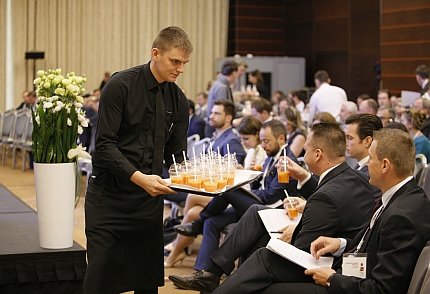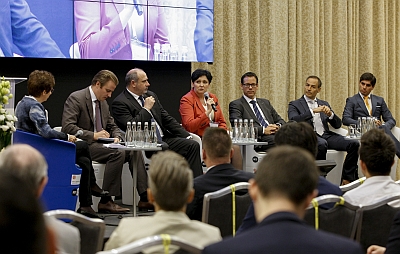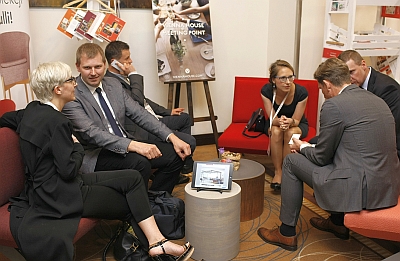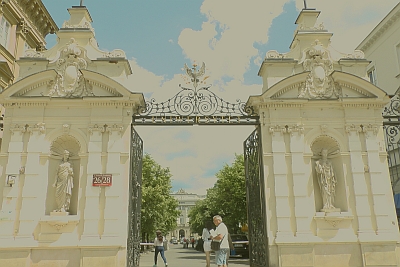3rd "Spotlight Hotel Investment Poland": Hotel industry still in demand
 |
|
| An energy drink served at the beginning of the conference at the InterContinental Warsaw: Business in CEE picks up. |
Warsaw (July 22, 2016). The third conference "Spotlight Hotel Poland" in June in Warsaw showed that especially Poland is intensely discussing its market opportunities and is therefore clearly balancing opportunities and risks. Meanwhile more international investors and operators feel attracted by the country with a stable economic framework and a continuously increasing demand. Poland remains the driver in the CEE region.
Even if Poland may be the most progressive among the CEE countries, hotel operators and investors are still quickly encountering challenges: B&B project manager Malgorzata Dybas located legal loopholes in the local building laws: Often the utilization was undefined. The Polish operator Puro faced difficult financing in smaller cities, "whereas in more prospered locations it is difficult to find the right location," complained Przemyslaw Wieczorek, member of the Board. Valerie Schuermans, Director Business Development of the Rezidor Hotel Group with lots of experience in emerging markets such as Russia or Africa advised also to show “patience” for Poland. "The price regulates the market," as Wieczorek of Puro continues – and this is often stressful for Polish market players since "international investors are often willing to pay more" (than national investors).
There was no agreement in the discussion to whether new constructions or conversions could reach the goals faster. It is said that it is has become almost impossible in Warsaw to identify properties for new constructions. But despite the shortage, Puro still advised for new constructions – due to timetable and financial reasons. The return on conversions is always dependent on the area utilization – which is a known fact especially among budget operators. On top, the preservation order also has its say in this issue. Rezidor’s Schuermans reasoning that old buildings often have a "story" to tell was not convincing. The discussion only brought one agreement on the statement: Every calculation is dependent on the sales price and this has even become the most crucial factor in Poland.
 |
|
| International operator, all looking for locations, in discussion: (from right) the representatives of IHG, Vienna House, Worldhotels, AccorHotels, B&B, Kempinski. |
Returns attracting internationals
These types of discussions can also be found in saturated markets – therefore Poland is not really part of the "emerging markets" any longer. The country is still interesting since operators such as Louvre are sure to be able to generate returns of 7%. "International investors will come", predicts Saurabh Chawla, Head of Group Development of the Louvre Hotels Group, also since this level of return is higher than in Western Europe. Lukas Hochedlinger, Managing Director Germany, Austria and CEE of Christie & Co, adds: "I would prefer to invest my money in hotels – there is a great demand from Croatia to Slovenia to Poland, a return for long-term leasing of 6% is great." (See also previous article / see link). Hubert Manturzyk, Senior Manager of the (German) Aareal Bank held against this optimism: The exit in Poland remains difficult, but still Aareal Bank wants to co-invest heavily in Polish hotels.
It was still a mutual understanding that international investors would come to Poland due to the favourable economic framework and the increasing demand of business travellers and tourists (by the way, no one was willing to discuss the current political direction of the government; this issue always caused a deafening silence). Therefore everyone was eager to know what the banks’ opinion would be. There was a slight pro-Zloty trend visible in due course of the Euro-Zloty-debate in hotel financing in the past year, whereas mLeasing (subsidiary of the mBank) makes their credit periods dependent on the currency: a ten-year credit period is granted by amortisation in Zloty, five years by amortisation in euros – beyond this, it becomes more expensive.
The participants concentrated at the end of the discussion on the Loan-To-Value (LTV), which banks are already applying in several ways: For example the Alior Bank beginning at 60% (reliable projects and chains until 70%), Pekao rather prefers 60-65% "due to security reasons".
When talking to unemotional bankers one could still sense a subliminal desire for financing in the air: They are also realizing that the popularity of the asset class hotel is rising and investors and operators in this segment estimate and cope differently with critical stages within the real estate cycle. One thing would be welcomed by all bankers: more benchmarks in the individual countries!
 |
|
| Networking in the conference breaks... |
Minor destinations
would also like to benefit
In order to divert the attention of large investors, banks and operators from the top Polish locations, various regions jointly presented themselves in a panel about the "rising stars". For the non-experts of the Polish country, it was somewhat difficult to filter their actual potential, since the regional representatives did not bring their arguments forward in a persistent fashion, namely with facts and figures.
From the city-trio Lublin, Gdynia and Nysa it was Nysa which stood out from the rest: The Silesian city in the Southern part of Poland and its 25,000 inhabitants promotes its lake, the countryside and peacefulness, but also events – like the World Championship for Water Skiing in 2016 or festivals with fire and water. The surroundig area of Nysa counts about 400,000 people, as Marek Rymarz, the Deputy Mayor of Nysa promoted his place in front of many investors in the conference room. And who is not particularly fond of water sports for example, heads for the Czech Republic, just 20 km away to go skiing.
On the other side, Lublin is strongly promoting its new congress centre and Gdynia focuses on business travellers – together with Gdansk and Sopot, the other two cities within the Tri-City.
The conclusion of the third conference "Spotlight Hotel Investment Poland": The last twelve months did not move much, at least not for Poland. All market players are identifying and analysing not only the major cities any more. The conference focus was naturally set more on Poland due to the conference location Warsaw. It would have also been appropriate to give adequate space and time for other CEE markets, which are currently in an upswing. Maybe during the next conference. / map
|
THE OVERALL MARKET VIEW ON CEE The latest economic facts about CEE reveal the region's mission: to outperform. Jaguar Land Rover invests $1.6bn in Slovakia, the world's first Hyperloop railway will connect Bratislava and Vienna in 20 minutes, Poland and the Czech Republic sign strategic deals with China, Germany's most important trading partner is the V4 group, and nine Romanian cities are among the top 15 cities with the highest Internet download speed in the world. If these facts surprise you then it is high time to catch up with the latest facts and explore the economic and investment potential of the region in the latest "CEE Investment Report 2016: Mission to Outperform", compiled by Skanska, JLL, Dentons, in cooperation with ABSL (see below).
In 2015, GDP growth in CEE (3.1%) was nearly double that of the euro area (1.6%). The long-term GDP outlook seems to be similarly positive. The highest GDP growth is expected in Lithuania (3.6%), Poland (3.5%), Estonia (3.4%) Romania (3.3%), Slovakia (3.2%) and Hungary (2.1%). CEE is one of the safest parts of the world in terms of business operational risk - threats common in emerging economies, such as geopolitical and social risks, are not present in the region. The Czech Republic, Slovenia, Poland, Hungary and Slovakia are all ranked in the world's 25 safest countries, according to the Institute for Economics and Peace. More facts:CEE, with its approximately 100 million people and strong economic indicators is a region with a strong focus on increasing its performance in terms of growth. Developing much faster than Western Europe, it is one of the growth engines of the EU economy. Foreign direct investment (FDI) is one of CEE's strongest growth engines. The region is experienced in advanced business services, IT and back-office operations, which are currently on the list of the most popular services for FDI in Europe. "Apart from favorable macroeconomic conditions, what matters to investors is the region’s well-educated, hardworking and talented labor force. Every year CEE produces 1.2m graduates, many of them with high working proficiency in languages which they use on a daily basis…. People are the real power of this region," says Katarzyna Zawodna, President of Skanska Commercial Development Europe. Investment funds and real estate agencies point out that in CEE there is still a need for prime offices, shopping centers, and logistics infrastructure. "CEE offers 24m sqm of modern office space. Yields are higher than in Western Europe and therefore a combination of attractive risk-adjusted pricing and the availability of institutional quality product delivered by experienced developers provide multiple investment opportunities," comments Tomasz Trzósło, Managing Director, JLL Poland. "Central and Eastern Europe is viewed as Europe's 'Darling' by an increasing number of institutional investors based in Europe, including the UK, and more recently from North America, South Africa and the Far East. It is an attractive and safe region with sustained improvements in the business environment. This is particularly evident in the commercial real estate sector, where investors can tap into products that deliver profitable yields and long-term profits…" says Paweł Dębowski, Chairman, Real Estate (Europe), Dentons. The "CEE Investment Report 2016: Mission to Outperform" is a short analysis of the region's potential as an investment location, focusing on Poland, the Czech Republic, Romania, Hungary and Slovakia. The report was compiled by Skanska (development and construction), Dentons (global law firm) and JLL (real estate services) in cooperation with ABSL / Association of Business Service Leaders in Poland. The report was officially presented on June 29, 2016 and is available for free download here. / red |
Continuative Links:
- July 1, 2016 A fresh breeze for everyone - 3rd "Spotlight Hotel Investment Poland": The entire CEE with good news
- July 22, 2016 Market report Poland on a stable course
To print this article you have to be registered and logged in for newsletter, visitor or subscription.






